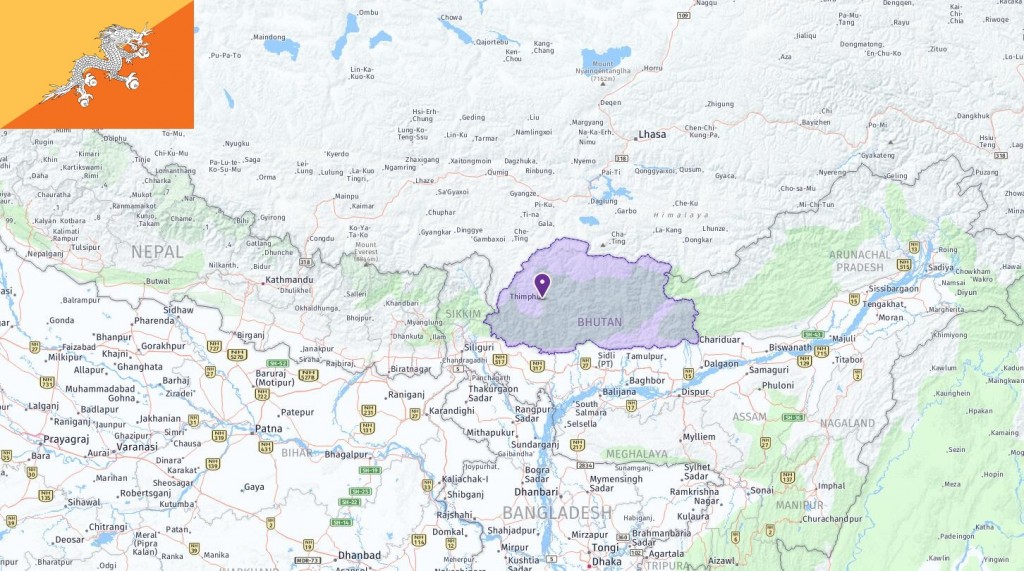BT is the abbreviation for Bhutan, the 133rd largest country in the world. Officially Kingdom of Bhutan, Bhutan is a country located in South Asia, bordering China and India. Thimphu is the capital city of Bhutan. Other major cities include Thimphu (population: 98,676), Punakha (population: 21,500), Tsirang (population: 18,667), Phuntsholing (population: 17,043), Pemagatshel (population: 13,864), Sarpang (population: 10,416), Wangdue Phodrang (population: 7,507), Samdrup Jongkhar (population: 7,507), Samtse (population: 5,479), and Jakar (population: 4,829).
Country Profile
- Capital: Thimphu
- Language: Dzongkha
- Area: 38,394 km2
- Population: 727,145
- Currency: Ngultrum (BTN)
- Time zone: UTC+6
- Calling code: 975
- ISO 2-Letter Abbreviation: BT
- UN 3-Letter Abbreviation: BTN
- Internet TLD: .bt
- State Government Website: http://bhutan.gov.bt
List of Bhutan Acronyms
The most commonly used abbreviations about Bhutan are BT which stands for Bhutan and BTN which means Ngultrum (Bhutan currency). In the following table, you can see all acronyms related to Bhutan, including abbreviations for airport, city, school, port, government, and etc.

Geography
Bhutan is a small kingdom, located in the middle of the Himalayas, sandwiched between India and China. In the south there are grasslands where the majority of the population lives. At the far north of the country are the high mountains that extend more than 7000 meters above sea level.
The climate in the country varies depending on the altitude you are at. The higher the sea one is, the less rainfall falls. It rains mostly in the south. Storms coming from the mountains are why more people call the land Druk Yul, which means the land of the thunderstorm.
History
The Bhutan area has been inhabited for about 4,000 years. It is believed that the country’s geographical location has been important for the country’s development and residents, with several important mountain passes between China and India. There is little evidence of Bhutan’s early history, but the area was used by Tibetan monks and the religion of Buddhism has dominated the area since the 6th century. The country was united into one empire in the 1600s, and developed a national and strong uniqueness, although it has been dominated by the great powers of China and India/Great Britain throughout history.
At the beginning of the 20th century, the country introduced monarchy. The country has been independent in modern times, but has had an agreement to follow the UK in foreign policy, against the British not interfering in domestic affairs. After 1949, India took over this “deal”. The relationship between India and Bhutan is still special, and India protects the small country and has a strong influence on its foreign policy.
For a long time Bhutan was a closed country. Only in the 1960s did the slow development towards a modern society begin. In the 1980s, the king wanted to strengthen the national identity of the country. Nepali lost official language status. The government worked on a law that made many South Bhutanese stateless. Many therefore fled to Nepal and in the early 1990s, more than 100,000 lived in the UN refugee camp in Nepal. This led to external pressure and pressure to democratize the country. In 1996, the king gave up his sole power, and in 2007 the first free elections were held.
Society and politics
Bhutan has undergone a gradual transition from being a monarchy to becoming a parliamentary democracy. Political parties were banned until 2007. The country’s first written constitution came in 2008, and is intended to guarantee fundamental rights and freedom. Bhutan is now a democratic constitutional democracy with two political parties. The political parties are loyal to the king, who still has a lot of power in the country.
The king is still very powerful and appoints a number of important people. Among other things, the king chooses several key people in the defense. For a long time Bhutan was characterized by poverty, high infant mortality and low life expectancy. The situation has improved and life expectancy has increased by 20 years in a couple of decades. There is little extreme poverty in the country.
To protect nature and Buddhist culture, Bhutan has an annual quota that determines how many tourists are allowed to visit the country. In 2004, Bhutan became the first country in the world to ban tobacco sales. An increasing number of Bhutanese are moving to the cities, but the majority of the population still live in small villages. Agriculture and animal husbandry are an important source of food for several Bhutan residents.
Economics and Commerce
The level of development in Bhutan has long been extremely low, and by the mid-1900s, the country was largely missing everything associated with the modern world. Traditionally, the country’s economy has been based on agriculture and agriculture. Only in 1999 did foreign investment in the country begin, and in a short time the country developed rapidly. Bhutan has large natural resources in the form of hydropower, forests and minerals, but most of the resources are currently untapped.
India is Bhutan’s most important trading partner. Bhutan’s foreign economy is strongly linked to exports of hydropower to India. Exports are increasing in line with the expansion of the Bhutan hydropower sector. Other important export items are electric power, cement, timber, electricity and fruit. Main import items are vehicles, machinery and parts, diesel oil and rice. A large part of the country’s state budget is funded by aid. In recent years, Bhutan has experienced increased economic growth.
View this article in other languages:
Deutsch – Français – 繁體中文


